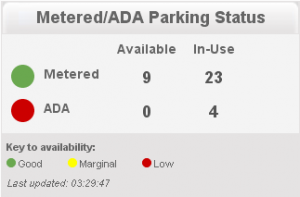
Screen capture of live parking information for Fort Totten. Click image for live site.
As part of Metro’s ongoing effort to make parking more convenient for riders, a trial of real-time sensing has been underway at the Fort Totten Metro Kiss and Ride Lot for the past few months. This system uses sensors embedded in the pavement and in parking meters to let users know when spaces are available in the Kiss and Ride Lot, and when they should save time, energy and reduce their carbon footprint by driving to a different lot or using some other mode to access Metro. Eventually, we hope that a similar sensors and monitoring technology will be available at all Metro metered parking spaces as a customer service to riders and to improve transit access, information and use. Information on parking space availability reduces traffic cause by motorists search for parking and reduces pollution from vehicles being driven around in the search for parking.
This real-time space availability information from the Fort Totten Kiss and Ride Lot is currently available on Metro’s website on the Fort Totten parking page:
http://www.wmata.com/rail/parking/parking_detail.cfm?station=28
Read more…
May 5, 2011

In May, we continued to provide the TAG with model results of several strategies aimed to improve surface transit in the region, such as an enhanced priority corridor network, streetcar network, and light rail extensions. This round of modeling also tested new Metrorail lines including a beltway line and new brown line. Finally, additional Metrorail enhancements were considered such as a relocated silver line with a Ballston-Rosslyn bypass, and a new set of extensions to suburban activity centers. The results of these model runs show the impact of each of these strategies on weekday transit boardings by mode, Metrorail boardings by line, regional transit share, regional transit linked trips, as well as an examination of passengers per rail car during the peak hour. The strategies modeled during this round address the need to increase core system capacity, connect to new and emerging markets, and provide priority for and enhancements to surface transit corridors in the region – three of the four goals of the RTSP.
Download the Meeting Materials: TAG_07_Meeting.pdf (PDF, 3.1 MB)




Recent Comments